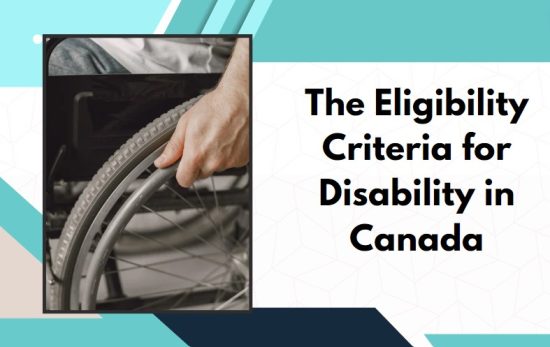Introduction
Living with a disability can be challenging, especially when it comes to navigating the Canadian social security system. Applying for disability benefits can seem like an overwhelming and confusing process, but don’t worry! We’re here to help you every step of the way. In this comprehensive guide on how to apply for disability in Canada, we’ll walk you through everything you need to know about eligibility criteria, application procedures, waiting times and more. Whether you’re applying for short-term or long-term disability benefits in Ontario or any other province across Canada, our step-by-step guide will ensure that your application is successful and approved as quickly as possible. So let’s get started!
The Eligibility Criteria for Disability in Canada

Before discussing how to apply for disability in Canada, it’s important to understand the eligibility criteria. In general, those who are applying for disability benefits must have a physical or mental impairment that is severe and prolonged. This means that the condition must be expected to last for at least one year or result in death.
- To be eligible, applicants must also have worked enough hours and paid into the Canada Pension Plan (CPP) or Quebec Pension Plan (QPP). The number of hours required depends on your age and when you became disabled.
- Additionally, applicants cannot be working at their full capacity due to their disability. This means that they are either not working at all, working part-time with reduced earnings, or unable to perform duties related to their occupation.
- It’s also worth noting that there are different types of disability benefits available in Canada depending on your situation. For example, if you were injured on the job, you may qualify for workers’ compensation instead of CPP disability benefits.
- Meeting these eligibility criteria is crucial when applying for disability benefits in Canada. It’s important to carefully review them before beginning the application process.
How Do You Qualify for Disability in Canada?
To qualify for disability in Canada, you must meet certain eligibility criteria.
- First and foremost, your medical condition must prevent you from performing any substantial gainful activity (SGA). SGA refers to work that pays enough to support yourself without relying on government assistance.
- Next, your condition must be severe and long-lasting or terminal. It should also be expected to last at least one year or result in death.
- The Canadian government provides a list of impairments that may automatically qualify you for disability benefits. These impairments include but are not limited to cancer, multiple sclerosis, bipolar disorder, HIV/AIDS and severe arthritis.
- Even if your medical condition is not on the list of automatic qualifiers, you can still apply for disability benefits if it meets the above-mentioned criteria. However, keep in mind that meeting these conditions does not guarantee approval of your application.
- It’s important to note that there are separate programs available for individuals who have temporary disabilities or injuries resulting from a work-related incident.
How to Apply for Disability in Canada?

Applying for disability in Canada can be a complex process, but it is important to understand the steps involved.
Here’s what you need to know about how to apply for disability in Canada:
- Gather your documents: Before applying for disability benefits, make sure you have all of the necessary documentation that proves your eligibility. This includes medical records from doctors and specialists who have treated your condition.
- Fill out an application form: You can apply online or by mail using the Disability Benefits Application form available on the Government of Canada website. The application form will ask questions about your personal information, work history, and medical condition.
- Submit your application: Once you’ve completed the application form and gathered all of your supporting documents, submit them either online or by mail according to the instructions provided on the government website.
- Wait for a decision: After submitting your application, you will receive a confirmation notice stating that Service Canada has received it. The processing time varies depending on each case; however, it typically takes up to several months before receiving a final decision.
It’s important to note that if your initial claim is denied or rejected based on insufficient evidence being provided – there are options to appeal and seek further assistance with legal representation if required.
Navigating this process may seem daunting at first glance – but taking one step at a time towards securing much-needed support through disability benefits could provide long-term stability and peace of mind about financial security while dealing with difficult health circumstances
How Long Does It Take to Get Approved for Disability in Canada?
The time it takes to get approved for disability in Canada can vary depending on several factors, such as the completeness of your application, the complexity of your medical condition, and the current backlog of applications being processed by the government agency responsible for reviewing disability claims.
On average, it can take anywhere from several months to over a year to receive a decision on your application. However, some applicants may be approved within a few weeks if their case is straightforward and well-documented. It’s important to keep in mind that there are no guarantees with the disability application process, and it can be frustratingly slow at times.
How Much Are Canada’s Disability Benefits?
The Canada Disability Benefit (CDB) provides financial assistance to individuals who have a severe and prolonged disability that prevents them from working. The amount of CDB you can receive depends on various factors such as your age, family situation, income level, and the severity of your disability.
The maximum monthly amount for an adult with a single, married, or common-law partner is $1,538 per month. Additionally, if you have children under 18 years old in your care, you may be eligible for additional funds through the Child Disability Benefit.
It’s important to note that receiving other sources of income may affect how much CDB you’re entitled to receive. This includes income from employment insurance benefits and pension plans in Canada.
To apply for the CDB program, it’s recommended that you contact Service Canada or visit their website to complete an application form. You’ll need to provide detailed information about your medical condition and financial situation as part of the application process.
Knowing how much support you could potentially receive through the CDB program can help alleviate some financial stress during a difficult time in your life.
How Long Can You Be on Disability in Canada?
If you are approved for disability benefits in Canada, the length of time that you can be on disability will depend on your specific circumstances. In general, there are two types of disability programs: short-term and long-term.
- Short-term disability benefits usually provide coverage for a period of up to six months. This type of benefit is designed to help individuals who are temporarily unable to work due to illness or injury.
- Long-term disability benefits may be available if you have a more serious medical condition that prevents you from working for an extended period. The length of time that you can receive these benefits will be up to 2 years.
It’s important to note that even if you qualify for long-term disability benefits, they may not last indefinitely. Some policies have limits on how long they will pay out, while others may require periodic reviews or reassessments to determine whether you still meet the eligibility criteria.
Ultimately, the length of time that you can be on disability in Canada will vary depending on several factors. It’s important to consult with your healthcare provider and insurance company to fully understand your options and what kind of support is available to help get back into employment when possible.
Who Qualifies for Long-term Disability in Canada?
Long-term disability benefits are available to those individuals who suffer from a disability that is expected to last for at least one year. In Canada, both private and government-sponsored long-term disability programs exist, with their eligibility criteria.
- To qualify for long-term disability benefits in Canada, an individual must first meet the definition of “disability” as outlined by the specific program they are applying to. This typically means that the individual’s condition must be severe enough to significantly impact their ability to perform daily activities or work.
- Additionally, most long-term disability programs require that the applicant have been employed and contributing financially before becoming disabled. For example, Canadian residents may be eligible for Employment Insurance (EI) sickness benefits if they have paid into EI and cannot work due to illness or injury.
- Other factors such as age and length of employment may also be considered when determining eligibility for long-term disability in Canada. It is important to carefully review each program’s requirements before applying, as these can vary widely depending on the type of benefit being sought.
How Long Does a Long-term Disability Last With Canada Life?
Long-term disability (LTD) is a type of insurance that provides financial assistance to individuals who are unable to work for an extended period due to illness or injury. Canada Life, one of the leading providers of LTD in Canada, offers coverage for up to two years or until age 65, depending on the policy.
- The duration of LTD coverage depends on various factors such as the severity and nature of the disability, medical evidence supporting it, and the individual’s occupation. Generally, if you have a severe disability that prevents you from returning to work for an indefinite period, your benefits may continue until you reach retirement age.
- Canada Life’s LTD plan also includes rehabilitation services designed to help employees return to their job as soon as possible. This can include training programs and vocational counselling aimed at developing skills necessary for alternate employment opportunities.
It’s important to understand your specific policy details regarding LDT when purchasing insurance with Canada Life or any other provider. Make sure you read through all terms and conditions carefully before signing up so that you are aware of what benefits apply in your situation should anything happen down the line.
Tips to get Quick Approval

Getting approved for disability in Canada can be a lengthy and complex process. However, there are some tips that you can follow to help expedite your application and increase the chances of getting quick approval.
- Firstly, it is important to ensure that you have all the necessary documents and information required for your application. This includes medical records, employment history, and any supporting documentation related to your disability.
- Another tip is to be thorough when filling out your application forms. Make sure that all questions are answered accurately and completely, providing as much detail as possible regarding your condition.
- It’s also helpful to keep track of deadlines throughout the process including submission dates for additional information or appeals if necessary.
- Having strong support from healthcare professionals who know you well can also help speed up the application process. They may be able to provide additional insights into how your disability affects daily life and work activities.
- Consider working with a qualified lawyer or advocate who specializes in disability cases. They can provide valuable guidance on navigating the system effectively while advocating on behalf of their clients.
By following these tips, applicants may improve their chances of receiving approval quickly while avoiding unnecessary delays in processing times.
Conclusion
Applying for disability benefits in Canada is a complex process that requires time, effort and patience. But if you meet the eligibility criteria and follow the steps outlined in this guide, you can increase your chances of getting approved for disability benefits.
Remember to gather all necessary documentation, be honest about your condition and limitations, and seek assistance from professionals or support groups if needed. It’s also important to understand the timelines involved in the application process and to have realistic expectations about the amount of financial support you may receive.
Ultimately, receiving disability benefits can provide much-needed relief for individuals facing physical or mental health challenges that affect their ability to work and earn income. By taking action today, you can start your journey toward accessing these valuable resources and improving your quality of life.










